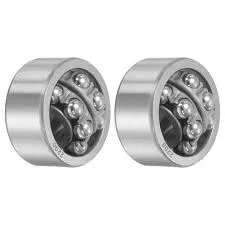
12월 . 09, 2024 23:59 Back to list
Benefits and Drawbacks of Tapered Roller Bearings in Various Applications
The Advantages and Disadvantages of Taper Roller Bearings
Taper roller bearings are a specific type of rolling-element bearing that can support both radial and axial loads. They are widely used in various applications, from automotive to heavy industrial machinery. The unique design of taper roller bearings allows them to handle significant amounts of load, making them a popular choice in many engineering applications. However, like any component, they come with their own set of advantages and disadvantages. This article will explore the merits and drawbacks of taper roller bearings in detail.
Advantages of Taper Roller Bearings
1. High Load Capacity One of the most significant advantages of taper roller bearings is their ability to handle large radial and axial loads. The tapered shape allows for a larger contact area between the roller and the raceway, distributing the load over a broader surface. This feature is particularly beneficial in applications involving heavy machinery or high-stress environments, such as construction equipment and transport vehicles.
2. Durability Taper roller bearings are designed to withstand harsh conditions. The use of high-quality materials, such as chrome steel, and advanced manufacturing techniques ensures that these bearings have a long service life. Additionally, they are resistant to wear, which decreases the frequency of maintenance and replacement, thereby saving costs in the long run.
3. Versatility Taper roller bearings are incredibly versatile and can be used in various applications. They are commonly found in automotive wheel hubs, gearboxes, and industrial equipment. Their ability to accommodate both radial and axial loads makes them suitable for a wide range of machinery, providing engineers with a reliable solution for diverse engineering challenges.
4. Self-Alignment Taper roller bearings can handle misalignments to a certain extent. This ability is beneficial in applications where perfect alignment is difficult to maintain due to manufacturing tolerances or operational conditions, allowing for smoother operation and reducing the risk of premature failure.
5. Reduced Friction Tapered rollers have a unique geometry that reduces friction between moving parts. Lower friction results in improved efficiency, allowing for higher rotational speeds and decreased energy consumption. This energy efficiency contributes to lower operational costs over time.
taper roller bearing advantages and disadvantages

Disadvantages of Taper Roller Bearings
1. Complex Installation The installation process for taper roller bearings can be more complicated compared to other bearing types. Proper spacing and alignment are crucial for optimal performance. Improper installation can lead to premature wear, increased noise, and ultimately bearing failure. This complexity can necessitate skilled technicians for installation, increasing labor costs.
2. Sensitivity to Misalignment While taper roller bearings can accommodate a degree of misalignment, they are not immune to it. Excessive misalignment can lead to uneven wear and eventually failure of the bearing. Continuous monitoring and maintenance are necessary to ensure that the operational conditions remain within tolerance limits.
3. Cost Although taper roller bearings offer high performance and durability, they can be more expensive than other types of bearings. The initial investment may be significant, especially for high-quality options. However, when considering the lifecycle costs, this expense can be justified due to the bearings' longevity and reduced maintenance needs.
4. Limited Speed Capabilities While taper roller bearings are proficient in handling heavy loads, their design can limit their maximum speed. In applications requiring high-speed rotation, other types of bearings, such as ball bearings, may be more appropriate. Thus, selecting the right bearing for a specific application is essential to avoid performance issues.
5. Temperature Sensitivity Taper roller bearings can be sensitive to temperature fluctuations. Operating at high temperatures can lead to changes in their characteristics, affecting performance and potentially leading to failure if not managed properly. Adequate lubrication and monitoring systems are critical in environments with temperature variations.
Conclusion
In summary, taper roller bearings are an excellent choice for applications requiring high load capacity and durability. Their versatility and design make them suitable for various industries. However, the complexities of installation, sensitivity to misalignment, and cost must be carefully considered. Proper selection, installation, and maintenance are crucial to maximizing the benefits of taper roller bearings while minimizing their drawbacks.
Latest news
-
Common Failures in Thrust Ball Bearings and Solutions
NewsAug.22,2025
-
How Tapered Roller Bearings Can Take Shock Loads
NewsAug.22,2025
-
Angular Bearings in High-Precision Spindles
NewsAug.22,2025
-
The Impact of Misalignment on Cylindrical Roller Bearing Performance
NewsAug.22,2025
-
The Role of Cage Design in Deep Groove Ball Bearing Durability
NewsAug.22,2025
-
The Impact of Material Quality on Machinery Bearings’ Lifespan
NewsAug.22,2025
